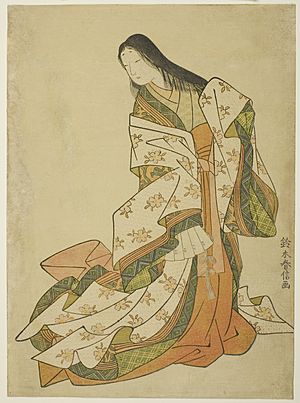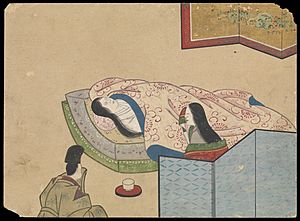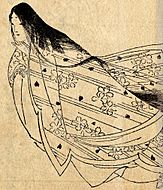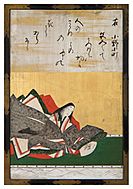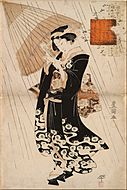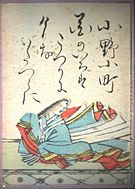Ono no Komachi facts for kids
Ono no Komachi (error: {{nihongo}}: Japanese or romaji text required (help)) was a famous Japanese poet. She lived around 825 to 900 AD, during the early Heian period. Komachi was known for her amazing beauty. Today, the name Komachi is even used in Japan to mean a beautiful woman. She is also one of the "Six Best Waka Poets" (called Rokkasen) and one of the "Thirty-six Poetry Immortals."
Her Life
We don't know much for sure about Komachi's life. Most of what we know comes from poems she exchanged with different men. These poems are kept in a collection called the Kokin Wakashū.
She was likely born between 820 and 830. She wrote most of her poems in the middle of the 800s. People have studied a lot to find out where she was born or who her family was, but there are no clear answers.
One old story says she was born in what is now Akita Prefecture. It suggests her father was Yoshisada, the Lord of Dewa. Her social standing is also a bit of a mystery. She might have been a lady-in-waiting or a low-ranking helper for an emperor.
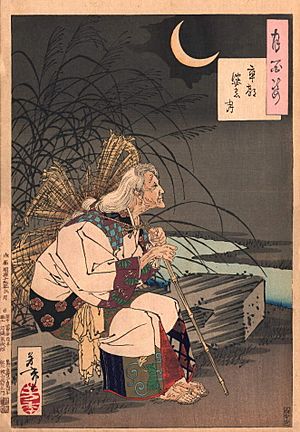
Famous Legends
Many stories and legends about Komachi began to appear as early as the 1000s. These tales were often used in traditional Noh plays.
- The Story of Ariwara no Narihira: One legend says she was admired by Ariwara no Narihira, another famous poet from her time. They were both part of the Rokkasen group. This story might have started because one of her poems was placed next to his in a collection.
- The Story of Fukakusa no Shōshō: Another well-known legend is about a high-ranking courtier named Fukakusa no Shōshō. Komachi promised she would be with him if he visited her for 100 nights in a row. He visited her every single night, no matter the weather. But sadly, he died on the ninety-ninth night, just before he could complete his promise.
- The Story of Her Old Age: A different type of legend tells of Komachi when she was very old. Her beauty had faded, and she was forced to wander around in old, torn clothes. People would make fun of her. This story suggests it was a punishment for how she treated her admirers when she was young and beautiful.
Her Poetry
Most of Komachi's poems that we still have are sad or thoughtful. They often talk about worry, feeling alone, or strong feelings of love.
In the Kokinshū poetry collection, almost all her poems were about "love" or "other topics." She is the only female poet mentioned in the introduction to this collection. The introduction says her style was "simple but also delicate."
One of her most famous poems is number 9 in Fujiwara no Teika's Ogura Hyakunin Isshu collection:
|
花の色は |
Hana no iro wa |
A life in vain. |
This poem was originally in the Kokinshū and was about spring. It has many layers of meaning, with almost every word having more than one sense.
The writer Donald Keene said that the strong feelings in Komachi's poetry were very new for her time. He felt that even though her poems were sometimes dramatic, they always seemed honest.
Her Legacy
Because of all the legends, Komachi is the most famous of the Rokkasen poets today. For a long time in Japan, if a woman was considered the most beautiful in a town, she might be called "XYZ Komachi."
She and Ariwara no Narihira are seen as perfect examples of female and male beauty. They both appear a lot in later Japanese stories and especially in Noh plays.
Komachi is often shown in later literature. Five Noh plays feature her: Sotoba Komachi, Sekidera Komachi, Ōmu Komachi, Sōshi Arai Komachi, and Kayoi Komachi. These plays often focus on her poetry skills and her relationships. They also show her in old age, when she has lost her beauty and feels regret. She is sometimes shown as a lonely beggar, but still admired for her poems. These stories are often influenced by Buddhist ideas about life's changes.
Komachi is also a common subject in Buddhist paintings called kusōzu. These paintings show her body at different stages of decay to teach about how life is not permanent.
The famous writer Yukio Mishima wrote a modern play based on Sotoba Komachi in 1952. In his version, an old Komachi meets a young poet in a park. She tells him stories from her life, which makes him fall in love with her, with sad results.
In her honor, a fast train in Japan, the Akita Shinkansen, is named Komachi. A type of rice, Akita Komachi, also has her name.
Images for kids
- Ono no Komachi image gallery
-
Ono no Komachi drawn by Kikuchi Yōsai
-
Ono no Komachi, from the Ogura Hyakunin Isshu.
See also
 In Spanish: Ono no Komachi para niños
In Spanish: Ono no Komachi para niños


